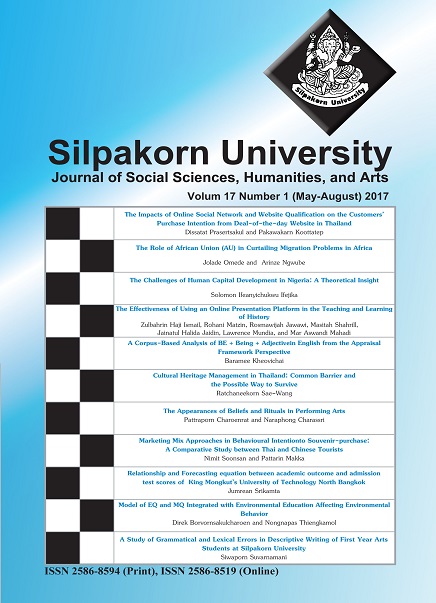A Corpus-Based Analysis of BE + Being + Adjective in English from the Appraisal Framework Perspective
Main Article Content
Abstract
This paper investigates the phraseological pattern BE + being + adjective. Specifically, it looks at the types of adjective meanings that can occur in this pattern, using Martin & White’s (2005) appraisal framework as the classification scheme, the grammatical subjects, tenses and engagement resources co-occurring with this phraseological pattern. The interplay of these linguistic features is investigated to shed light on the meaning and functions of the phraseological pattern. Data was drawn from the British National Corpus. The results indicate that there are 1,218 instances of this phraseological pattern in the corpus. The type of adjectives that occur in this pattern with the highest frequency is Judgment. Third person subjects, the present tense and Monogloss have the highest frequency in comparison with other categories of grammatical subject, tense and engagement resource, respectively. A closer look at the interrelation between different linguistic features leads to further findings and complex picture of how clusters of linguistic features can influence the meaning and function of this phraseological pattern.
Downloads
Article Details
All rights reserved. Apart from citations for the purposes of research, private study, or criticism and review,no part of this publication may be reproduced, stored or transmitted in any other form without prior written permission by the publisher.
References
Biber, D. (2006) University Language: A Corpus-based Study of Spoken and Written Registers. Amsterdam and Philadelphia: John Benjamins Publishing.
Biber, D., Johansson, S., Leech, G., Conrad, S., Finegan, E. & Quirk, R. (1999) Longman Grammar of Spoken and Written English. London and New York: Longman.
Burnard, L. (2000) User Reference Guide for the British National Corpus: Technical Report. Oxford: Oxford University Computing Services.
Bybee, J. & Dahl, O. (1989) The Creation of Tense and Aspect Systems in the Language of the World. Studies in Language 13: 51–103.
Cameron, D. & Panovic, I. (2014) Working with Written Discourse. Los Angeles, London, New Delhi, Singapore and Washington DC: Sage Publications Limited.
Conrad, S. (2010) What can a corpus tell us about grammar? In Routledge Handbook of Corpus Linguistics, pp. 227–240. Abingdon: Routledge.
Drackova, J. (2011) Stative Verbs with the Progressive. Unpublished master’s diploma thesis, Masaryk University, Czech Republic.
Fuchs, M. & Bonner, M. (2006) Focus on Grammar: An Integrated Skills Approach, 3rd ed., New York: Pearson Education Limited.
Granath, S. & Wherrity, M. (2014) I’m Loving You – and Knowing It Too: Aspect and So-called Stative Verbs. Rhesis: Linguistics and Philology 4(1): 2–22.
Huddleston, R. & Pullum, G. K. (2007) A Student’s Introduction to English Grammar. Cambridge: Cambridge University Press.
Hunston, S. & Francis, G. (1999) Pattern Grammar: A Corpus-driven Approach to the Lexical Grammar of English. Amsterdam and Philadelphia: John Benjamins Publishing.
Fuoli, M. (2012) Assessing social responsibility: A quantitative analysis of Appraisal in BP’s and IKEA’s social reports. Discourse & Communication 6(1): 55–81.
Graddol, D., Cheshire, J. & Swann, J. (1994) Describing language, 2nd ed., Buckingham: Open University Press.
Kennedy, G. (2003) Structure and Meaning in English: A Guide for Teachers. London: Pearson Education Limited.
Kranich, S. (2010) The Progressive in Modern English: A Corpus-based Study of Grammaticalization and Related Changes. Amsterdam and New York: Rodopi.
Levin, M. (2013) The Progressive Verb in Modern American English. In The Verb Phrase in English: Investigating Recent Language Change with Corpora, Edited by Aarts, B., Close, J., Leech, G. & Wallis, S., pp. 187–216. Cambridge: Cambridge University Press.
Martin, J. R. & White, P. R. R. (2005) The Language of Evaluation. Basingstoke: Palgrave Macmillan.
Mindt, D. (2000) An Empirical Grammar of the English Verb System. Berlin: Cornelsen.
Mindt, I. (2011) Adjective Complementation: An Empirical Analysis of Adjectives Followed by That-clauses. Amsterdam and New York: John Benjamins Publishing.
Phoocharoensil, S. (2014) If-conditionals in Authentic Corpus-based English. Review of European Studies 6(3): 62–73.
Romer, U. (2005) Progressives, Patterns, Pedagogy: A Corpus-driven Approach to English Progressive Forms, Functions, Contexts and Didactics. Amsterdam and Philadelphia: John Benjamins Publishing.
Saeed, J. I. (2003) Semantics. Oxford: Blackwell Publishing Press Oxford.
Sinclair, J. (1991) Corpus, concordance, collocation. Oxford: Oxford University Press.
Sinclair, J. (2004) Trust the Text: Language, Corpus and Discourse. London and New York: Routledge.
Smiecinska, J. (2003) Stative Verbs and the Progressive Aspect in English. Poznan Studies in Contemporary Linguistics 38: 187-195.
Smith, A. (2013) Complex Prepositions and Variation within the PNP Construction. In Perspectives on Patterns of Lexis, Edited by Hasselgard, H., Ebeling, J. & Ebeling, S. O., pp. 153–174. Amsterdam and New York: John Benjamins Publishing.
Smitterberg, E. (2005) The Progressive in 19th-century English: A Process of Integration. Amsterdam and New York: Rodopi.
Soars, L. & Soars, J. (2012) New Headway: Intermediate Students’ Book, 4th ed., Oxford: Oxford University Press.
Stefanowitsch, A. & Gries, S. T. (2003) Collostructions: Investigating the Interaction of Words and Constructions. International Journal of Corpus Linguistics 8(2): 209–243.
Swan, M. (2005) Practical English Usage. Oxford: Oxford University Press.
Vincent, B. (2013) Modality and the V wh Pattern. In Perspectives on Patterns of Lexis, Edited by Hasselgard, H., Ebeling, J. & Ebeling, S. O.,pp. 247–270. Amsterdam and New York: John Benjamins Publishing.
Yao, X. & Collins, P. (2013) Recent change in non-present perfect constructions in British and American English. Corpora 8(1): 115–135.


